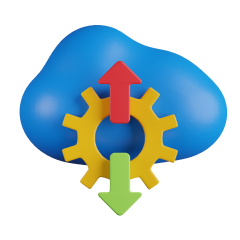
Got a Project? Tell us about it!
We are a leading custom software development agency focused on web, mobile app development & SaaS application development & MVP Development.
20 SAAS Metric Every Company Should Track
- Business
- SaaS Application Development
- Technology
Our experienced team of UX/UI designers and developers will help you stand out with a beautifully designed UX/UI.
20 SaaS Metric Every Company Should Track
1. Activation rate
The activation rate is the percentage of consumers who perform a specified action in order to benefit from your product. The moment of activation occurs when users recognize the product's value for themselves. Once this important point in the user journey has been identified, the organization may improve onboarding so that new users can quickly realize the value of the product, activate it, and begin to embrace it more fully.2. Active Users
Active users are a gauge of potential sales and a sign of good engagement. Users that visit your website, buy from you, read your material, or log into the dashboard of your product indicate that they are still satisfied with your services or product. Active users are an important indicator to track in terms of business operations. Active users, by definition, are those who have interacted with your users over a period of time. The length of time is crucial in this case.3. Customer Acquisition Cost
This is the cost of persuading and turning a consumer into a paying customer. Segmenting CAC into sales and marketing expenditures will better view client acquisition channels like PPC, paid ads, and sponsored content.4. Customer Lifetime Value
Customer Lifetime Value (CLTV), often known as Lifetime Value, is a notion that goes beyond CAC (LTV). CLTV stands for Customer Lifetime Value, which is the total money generated by a customer over the course of their SaaS subscription. Their LTV will be higher if their ARPA is higher and their turnover is lower. This measure provides two important insights. Having a distinct selling proposition helps to set your product out from the competition. Use this USP to provide unrivaled value to your users.5. Support Tickets Raised
This is just the quantity of people who require assistance and want their issues addressed. When the amount of tickets is high or projected, you may need to improve the product's usability or increase the quantity of customer support service providers. This statistic must be tracked and measured to assess the support team's effectiveness and determine whether or not your clients are satisfied with your service.Our experienced team of will help you stand out with a bespoke, flexible and scalable software application for your business.
6. Conversion Rate
The number of persons that started with a free trial and eventually converted to paying customers is known as the conversion rate or free trial conversion rate. Knowing how many users complete your website's targeted micro and macro goals will help you determine whether or not your product is effectively optimized. You can delve further into how your consumers interact with your product, what motivates them to take the required action, and where the bottlenecks are. This will aid in improving the overall functionality of the product as well as optimizing the funnel for better conversions.7. Churn Rate
You can't grasp LTV without first understanding and tracking the churn rate. Churn rate refers to the number of consumers who leave a company in a specific period of time. It can also be defined as the number of customers that have unsubscribed from your product in a certain time period. A high customer turnover rate indicates that your customers are no longer getting the value they expected from your product, or you don't have solid customer service and retention team. Customers who leave quickly indicate that they have found or will soon find someone who better meets their demands. It means higher acquisition costs for new clients.8. Customer Retention Rate
This indicator shows how effective your client retention efforts are and how loyal your user base is. A rise in this measure means your retention efforts are paying off, and you'll be able to generate more money from your existing user base. Let's use an example to grasp client retention rates better. You have 100 customers at the beginning of the month. The amount of consumers you have by the end of the month is 105. You gained 20 new clients and lost 15 throughout this time period.9. Customer churn rate
Churn, or customer attrition, is the polar opposite of retention. The customer turnover rate is one of the most important indicators of a startup's health. Churn becomes the defining factor for the maximum size a software company can reach as it expands. The KPI calculates how many customers or accounts leave the service in a certain time frame as a percentage of the total number of customers. It's critical to keep track of customer attrition rates monthly and annually. Even with an outstanding product, it is hard to maintain a zero churn rate, but firms should endeavor to keep it as low as feasible.Our experienced team of android developers will help you stand out with a efficient and fast mobile app for your business.
10. Customer satisfaction score (CSAT)
CSAT gauges a user's overall satisfaction or dissatisfaction with specific encounters with your organization, such as trying out a new product or service feature or having a talk with customer care. Conducting surveys at various stages throughout the client experience and before another subscription renewal is beneficial because it allows you to make improvements.11. Net promoter score (NPS)
NPS is the most popular approach to measure the amount of customer happiness and loyalty. It counts the number of promoters or customers who are likely to tell others about your product or service. Users are often asked to estimate this possibility from 0 to 10 and then classed according to their given points. It's good to track your NPS after product changes and have a few consumers complete daily in-app NPS surveys. You can follow up with the critics to find out what's bothering them and use their feedback to improve your product. Information about haters should be communicated throughout the organization so that all departments may work together to improve the overall customer experience.Our experienced team will help you stand out with a bespoke, flexible, and scalable SaaS application for your business.
12. Revenue churn
Revenue churn, also known as MRR churn rate, is a percentage of overall revenue that you lose each month due to customers quitting your business or downgrading subscriptions. Revenue churn is a better predictor of a SaaS company's health than client churn for most, but both should be monitored. In actuality, a 5% customer churn rate rarely translates into a 5% revenue churn, as certain customers generate more money than others. Even if you lose more customers than the previous month, successful upselling might result in better income. Negative revenue churn is the term for this.13. Customer acquisition cost (CAC)
CAC is known as the startup killer since many businesses have failed to discover a low-cost solution to acquire clients. You can use this indicator to assess your ability to produce new revenue through sales and marketing efforts. Scaling successfully requires knowing how much each client acquisition costs and identifying the most profitable marketing and sales channels. A SaaS provider should also track individual marketing efforts' cost per acquisition. It's critical to compute CAC separately if it generates leads from both paid and unpaid channels. This makes it evident which marketing strategy is the most cost-effective.14. Customer lifetime value (CLV, LTV, or CLTV)
You must cross-reference the CAC measure with your client's lifetime value for it to be helpful (CLV). It represents the average revenue made by a customer over the course of their account's lifetime. The higher a customer's CLV is, the longer they use your SaaS goods. The simplest formula to compute your CLV is ARPA divided by the customer turnover rate. It can help you realize whether it’s time to reassess your price and product marketing strategy, where your most important consumers are, and much more.15. Net Promoter Score
The Net Promoter Score (NPS) measures how satisfied customers are with your business. Whereas the previous metrics we've mentioned are based on internal benchmarks, NPS shows you exactly where you rank as a "value generator" in your customer's eyes. Your net promoter score measures the likability of your product. A high percentage of people who are likely to recommend also means you will need to spend less on acquisition because 'referrals' may bring in new consumers.16. Monthly Recurring Revenue
Monthly recurring revenue (MMR) is the income that businesses know they will get every month. MMR is calculated by multiplying the total number of paying customers by the average revenue per user. This measure can be broken down into three sub-metrics to assess your performance: new MRR, expansion MRR, and churn MRR. The bigger your dependable income or revenue, the more likely you are to stay in business. Therefore, MRR should continuously be rising.17. Annual Run Rate
It's the same as monthly recurring revenue (MMR), except it refers to revenue businesses know they'll get every year rather than every month. It is determined by multiplying MMR by 12 (months), resulting in the complete year's revenue. By assuming no changes occurred during the year, ARR assists firms in forecasting annual earnings and revenues for the following years. It can be utilized for long-term growth because it depends on yearly reports.18. Average Sale Price
It is the average price that clients pay when they first subscribe. To calculate ASP, you need to define all your subscription revenue and then divide it by the number of subscriptions. Understanding this metric can help you choose the best sales plan for your SaaS business. A low ASP indicates a self-service or low-service sales model; a high ASP, on the other hand, allows for high-oriented sales methods.19. Average Revenue per Account
ARPA is a monthly measurement of revenue provided by an "average" account or customer. ARPA will show you how your accounts perform monthly, whether you need to change the pricing for any particular cohort, and how your ARPA is evolving.19. Marketing Qualified Leads/Product Qualified Leads
A qualified lead is someone who has already entered your lead tracking system, fits specific requirements to qualify as a possible customer, and has expressed an interest in purchasing. An MQL is created when marketing qualifies a lead through branding, internet advertising, and other methods. Apart from MQL, product-qualified leads are gaining traction in SaaS. PQLs are potential consumers who have utilized a product and met certain predetermined triggers, indicating a high likelihood that these 'potential users' will become paying customers.Why Choose Us as Your SaaS Development Company?
Conclusion
The truth is that any business can be improved through better analytics and data-driven decision-making. Our mission is to help companies find their blind spots and fix them! To maximize your returns on investment, you'll want to track the right metrics for your business. So what are the best metrics? What should you be keeping tabs on that isn't already being tracked? The answer depends on your specific needs. To help you determine how many users are actively using your product, we've put together a list of 20 useful and effective KPIs to follow, and we are hopeful that this helps you. Some of these KPIs will help you assess how many users are actively engaged with your product, while others will show you how many users have abandoned ship (and why). These KPIs can be gathered with a simple Google Sheet or exported from most SaaS applications like Segment and Baremetrics.Got a Project? Tell us about it!
We are a leading custom software development agency focused on web, mobile app development & SaaS application development & MVP Development.
Subscribe to Our Newsletter
Join over 5,000 enterpreneurs and businesses who already have a head start.
Got a Project? Tell us about it!
Our Engagement Models
OUR PRESENCE
BLOCKCHAIN
OTHER SERVICES WE OFFER
CONTACT
Copyright © 2022 Mobirevo Software & Technologies LTD a company duly registered with CAC with RC Number: 1756190. All rights reserved.

Got a Project? Tell us about it!
We are a leading custom software development agency focused on web, mobile app development & SaaS application development & MVP Development.







